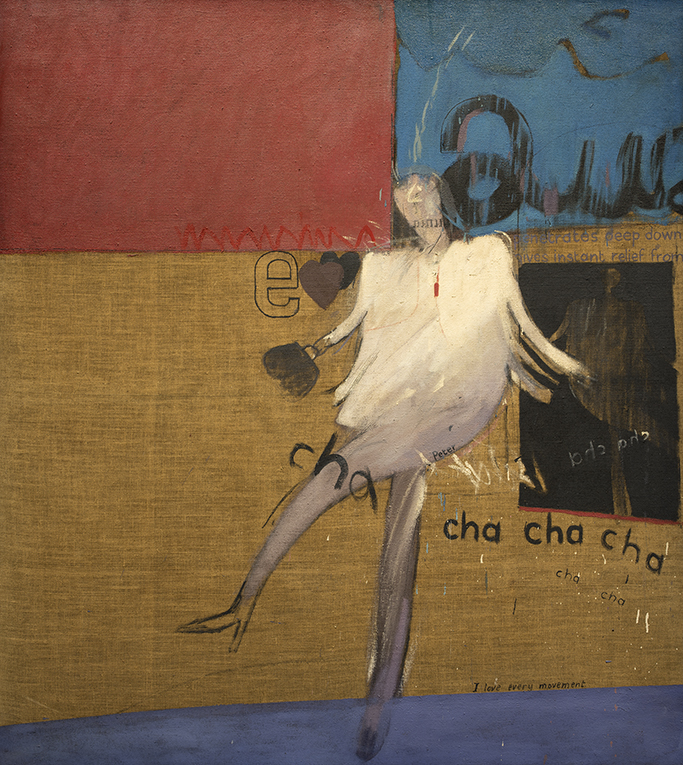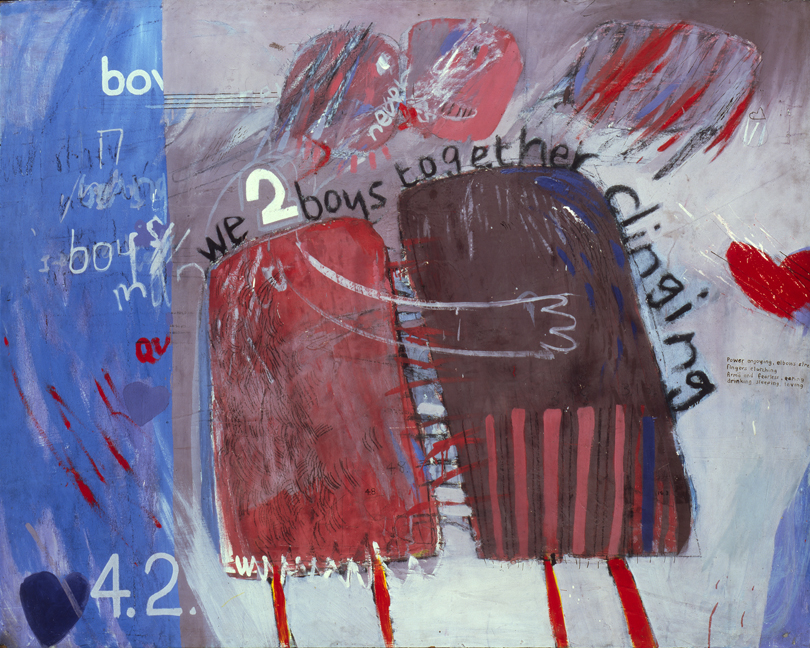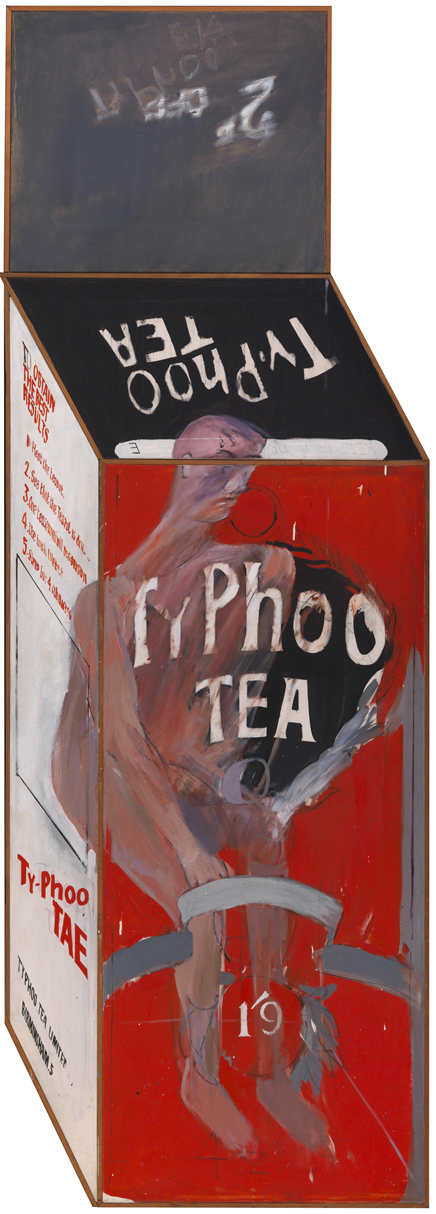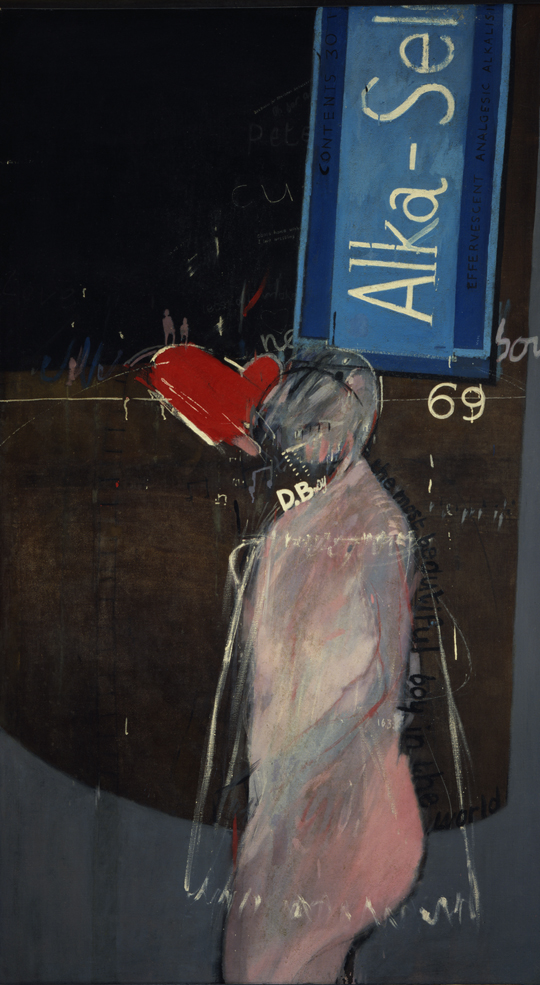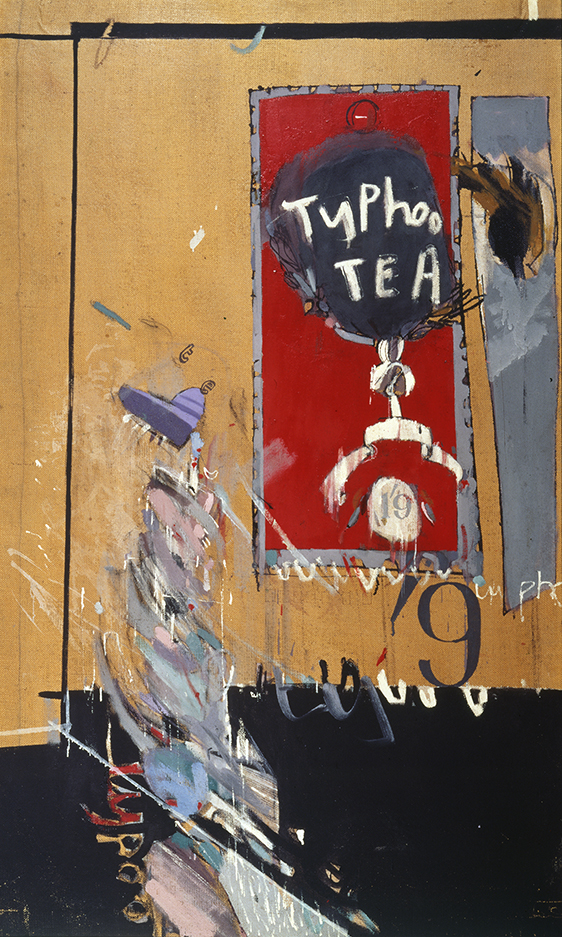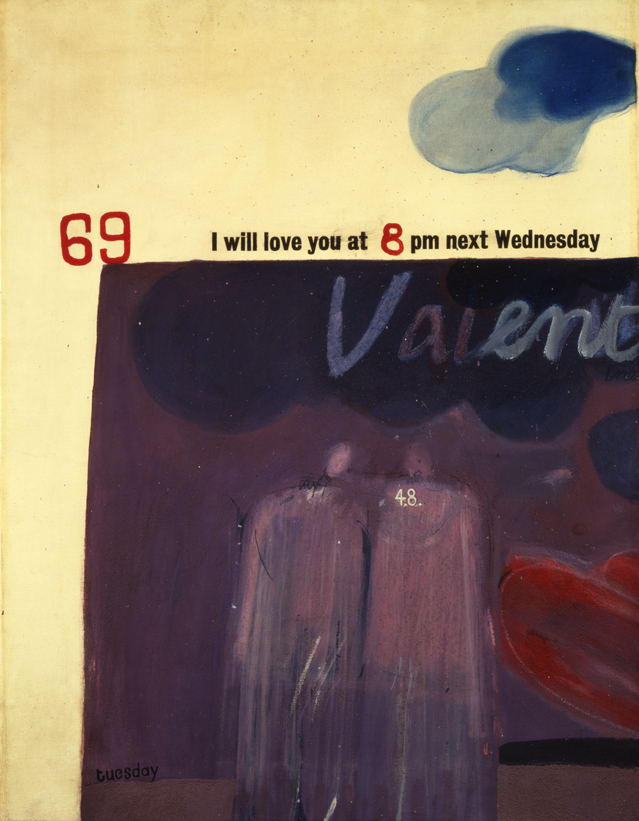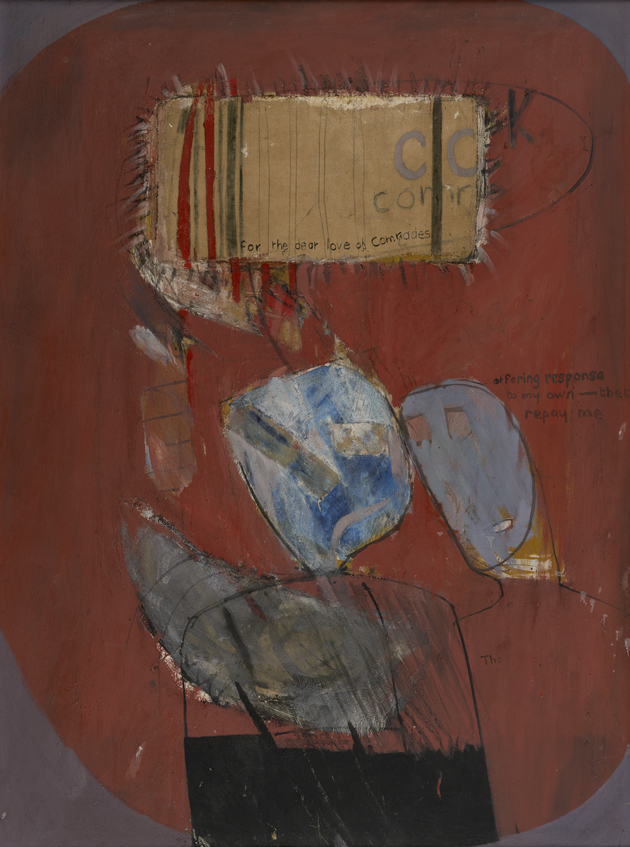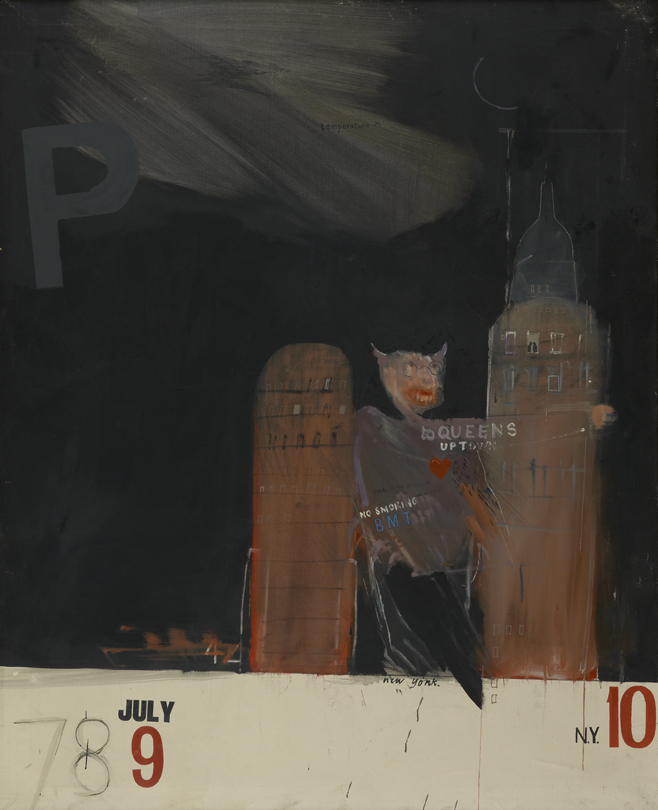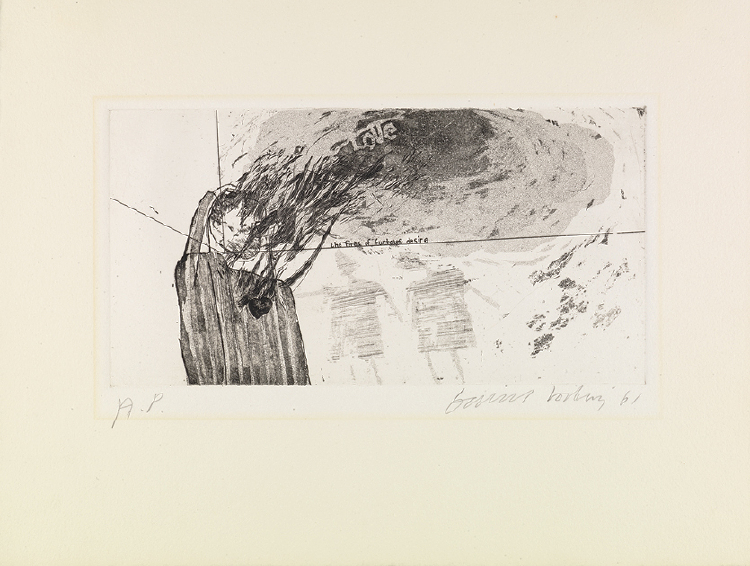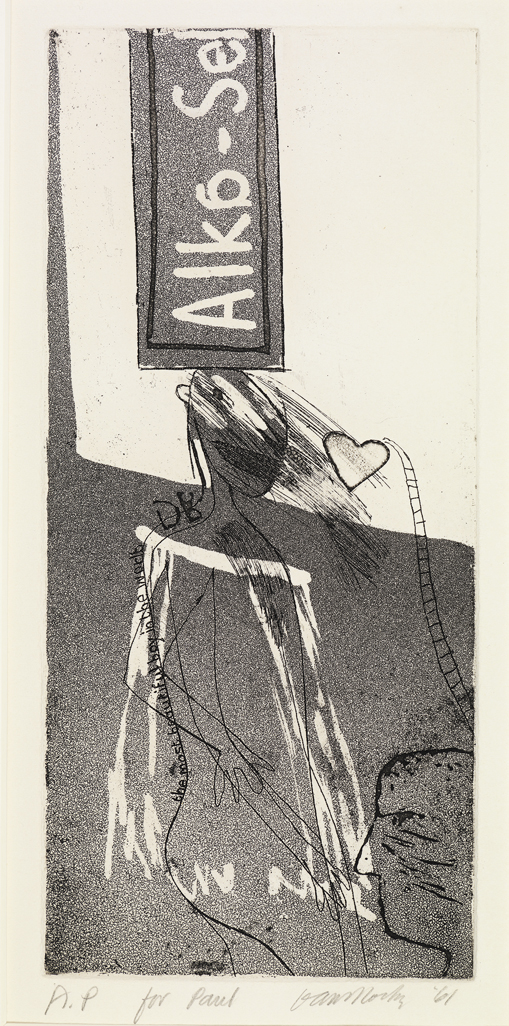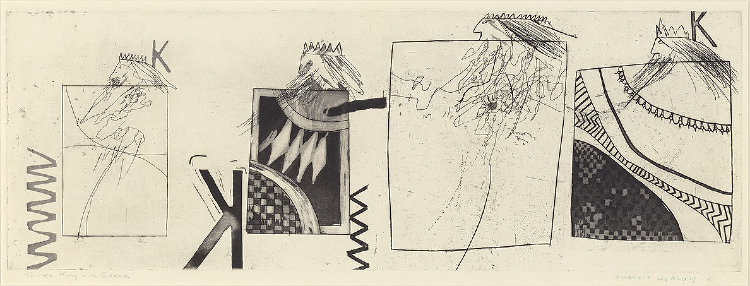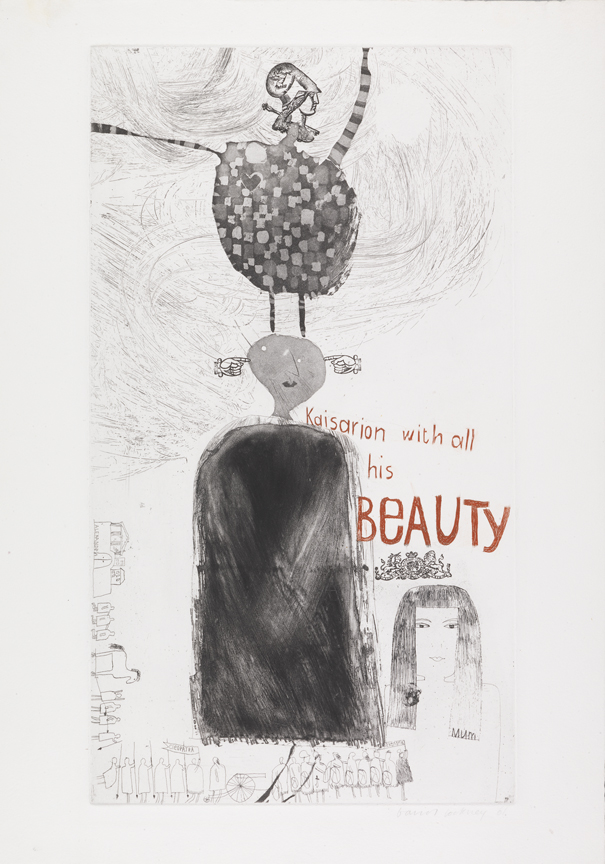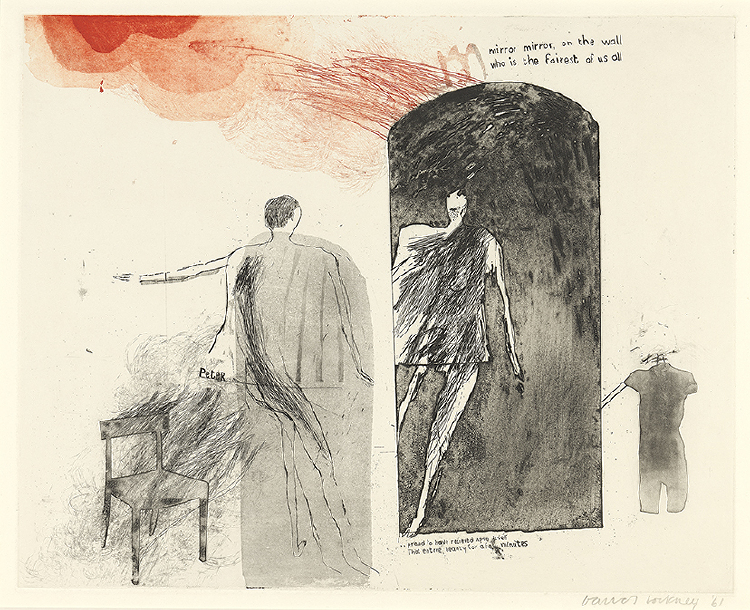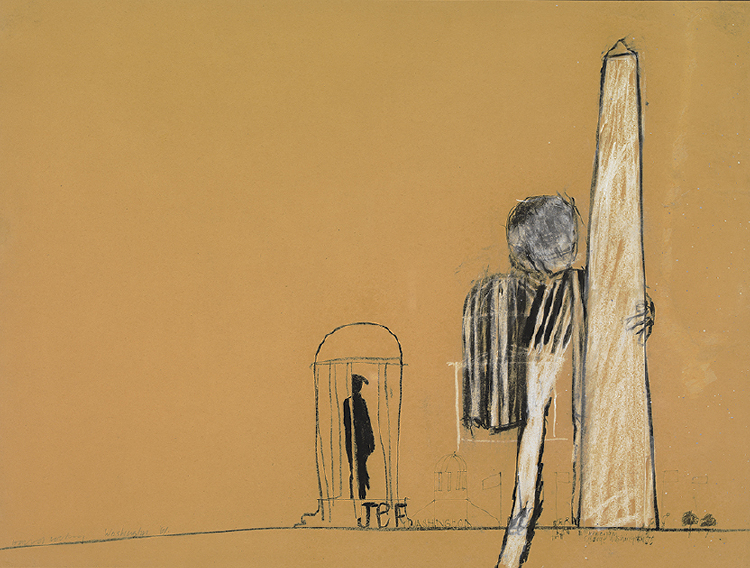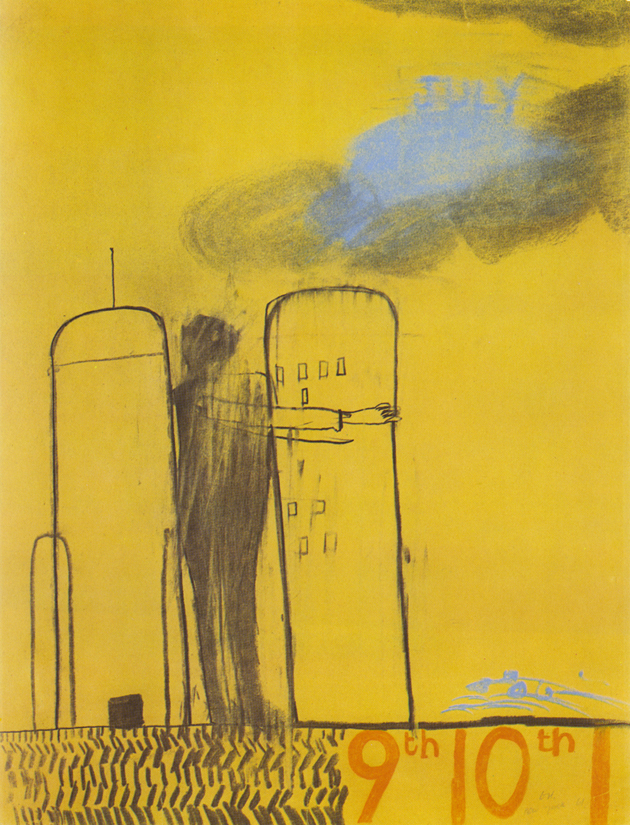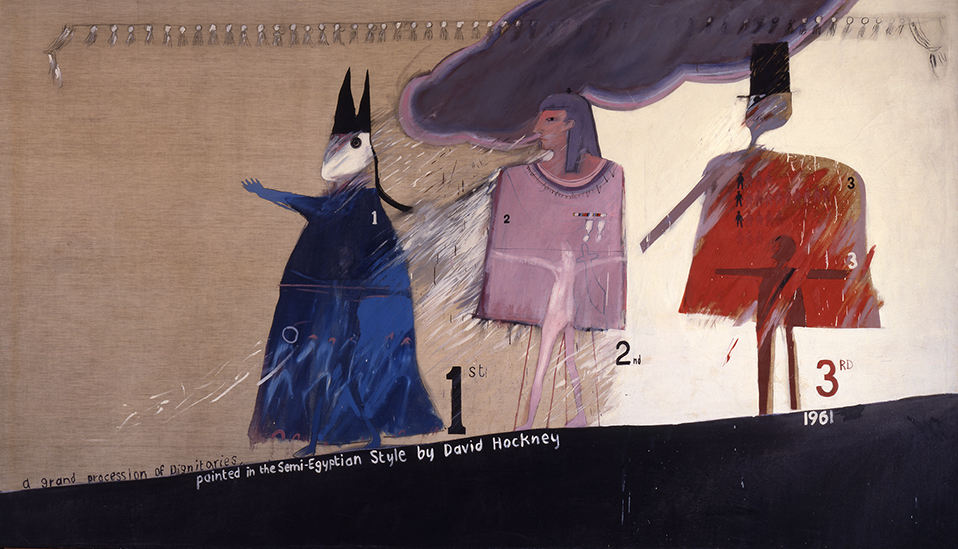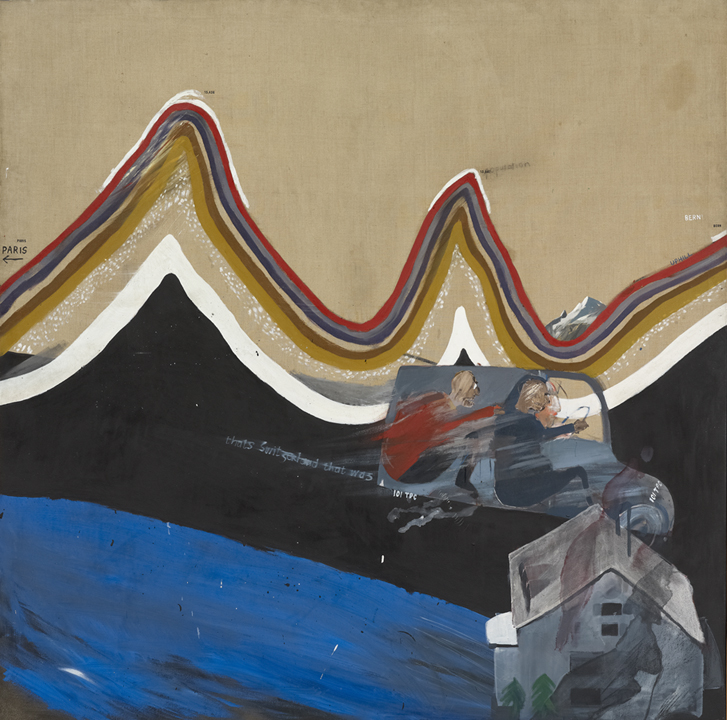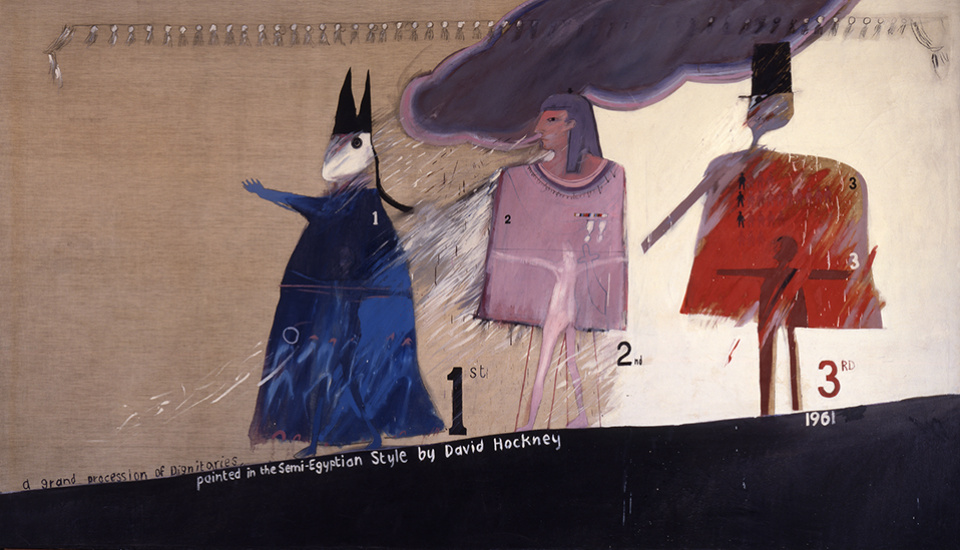
Young Contemporaries
For the second year in a row, Hockney’s work is featured in Young Contemporaries at the RBA Galleries in London, an exhibition that spotlights emerging artists of note. It is organized this year by Peter Phillips, who brings the Pop-inflected paintings of his fellow students at Royal College of Art to the fore. The review of the exhibition in the Times notes a disruption of the status quo: “Among the paintings it is noticeable that abstraction, and particularly the improvised, American-style abstraction, is ‘out,’ and that a new manner, sharply flavoured with the signs, slogans, and mordant humour of metropolitan life, and emanating mostly from the Royal College of Art, is ‘in.’ Mr. Phillips, with his colourful, heraldic evocations of press-button machines and amusement arcades, is its chief representative, aided and abetted by Allen C. Jones, Barrie Bates, David Hockney and Peter Kaye (the last three of whom introduce a weird, satirical element).”
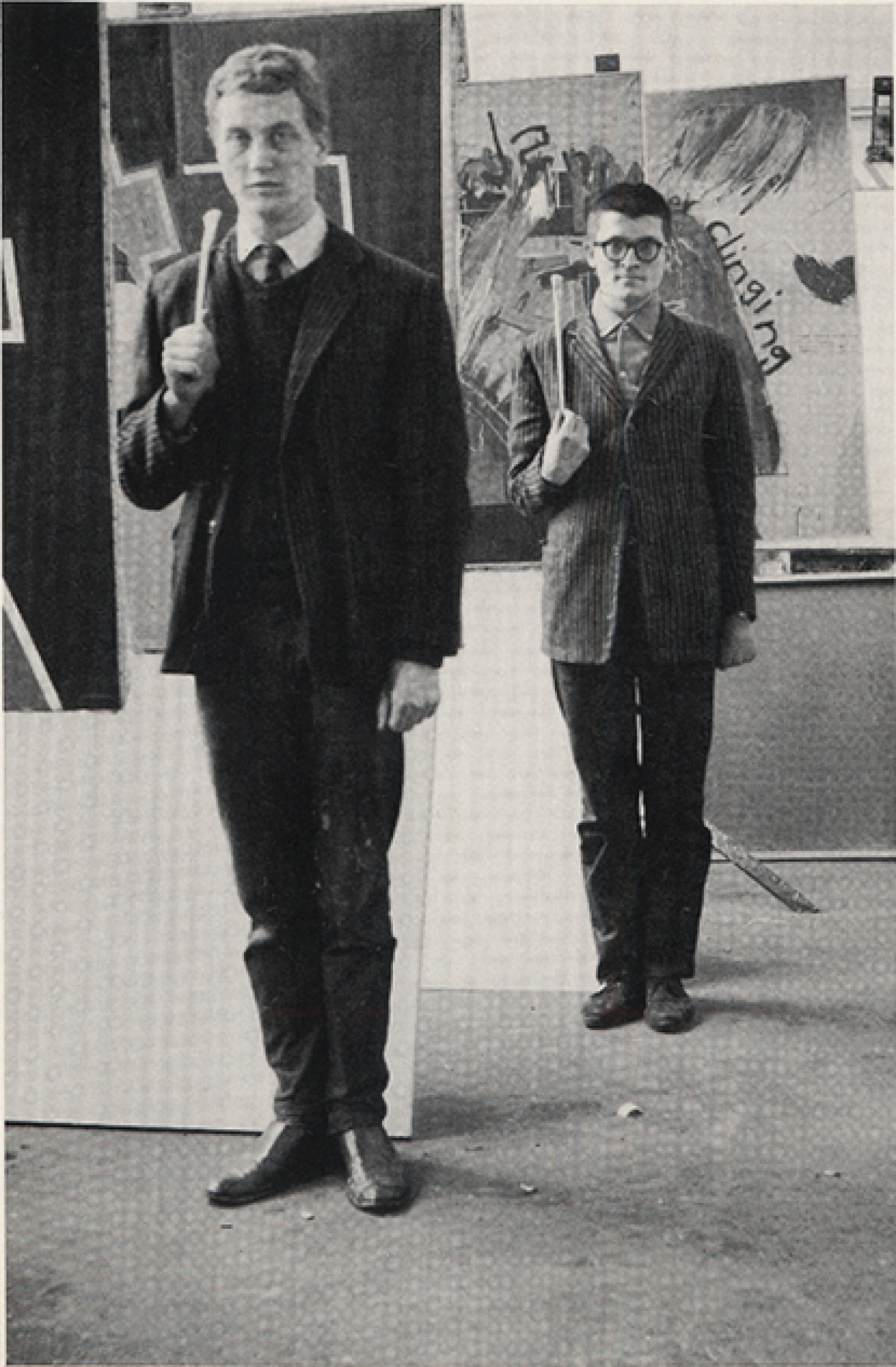
Working in the public eye at the RCA
Young Contemporaries results in a steady stream of visitors to the RCA, who look on at Hockney’s paintings in progress, including The Cha Cha That Was Danced in the Early Hours of 24th March 1961, We Two Boys Together Clinging, and Tea Painting in an Illusionistic Style. Among those drawn to Hockney’s work at this time is Mo McDermott, a textile design student from Manchester who meets Hockney and becomes one of his favorite models. In McDermott’s recollection, “I told him I loved his paintings, but he was very shy. He realized I came from the north and told me he did too. Then I told him I’d been modeling at St Martin’s and he asked me if I’d model for him.” Hockney also meets the dealer John Kasmin, then working for Marlborough Gallery in London, who personally acquires Doll Boy from 1960.
Tea Painting in an Illusionistic Style
Tea Painting in an Illusionistic Style is as close to Pop art as I ever came .… To make a painting of a packet of tea more illusionistic, I hit on the idea of "drawing" it with the shape of the canvas. The stretcher is made up from sections and I made the stretchers myself. It was quite difficult stretching them all up—the back is almost as complicated as the front; it took me five days. I don’t think anybody had done shapes before .… It’s interesting, I spelt the word "tea" wrong on the left-hand section; I am a bad speller, but to spell a three-letter word wrong! But it’s drawing in perspective and it was quite difficult to do. I took so long planning it that in my concern for flatness or abstraction I spelt it wrong.
Etching
Hockney is painting so much that he can’t consistently afford to buy materials. Fortuitously, he discovers he has a facility for etching, a highly affordable medium at the RCA given that the graphics department provides the materials free of charge. Among his early prints is Myself and My Heroes, which offers the line “I am 23 years old and wear glasses” and includes a self portrait (in army cap) along with the figures of Walt Whitman and Mahatma Ghandi.
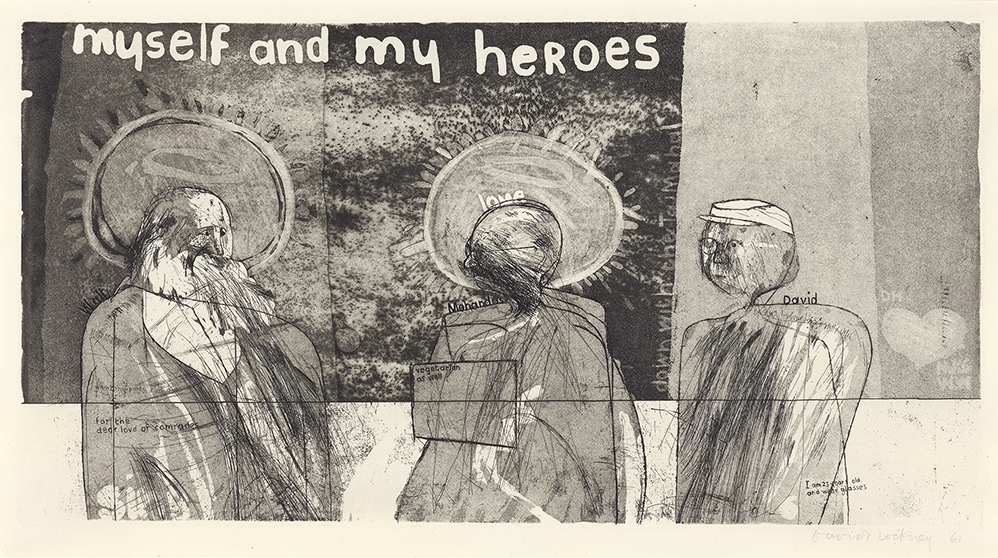
First trip to NYC
With the money from a Guinness Award for etching and a painting prize at the John Moores Exhibition, as well as from a commission to decorate the SS Canberra ocean liner along with several other RCA students, Hockney[NESTED] visits New York for the first time. He stays with fellow student Mark Berger and his parents on Long Island. One of the first stops Hockney makes is the Museum of Modern Art, where curator William S. Lieberman buys one of each print Hockney shows him. Lieberman is so impressed with the work that he sells all of the remaining prints for Hockney. Lieberman also introduces Hockney to the Pratt Institute in Brooklyn, where Hockney begins works on a new etching, My Bonnie Lies Over the Ocean.
The life of the city was very stimulating, the gay bars—there weren’t many in those days; it was a marvelously lively society. I was utterly thrilled by it, all the time I was excited by it. The fact that you could watch television at three in the morning, and go out and the bars would still be open, I thought it was marvelous.
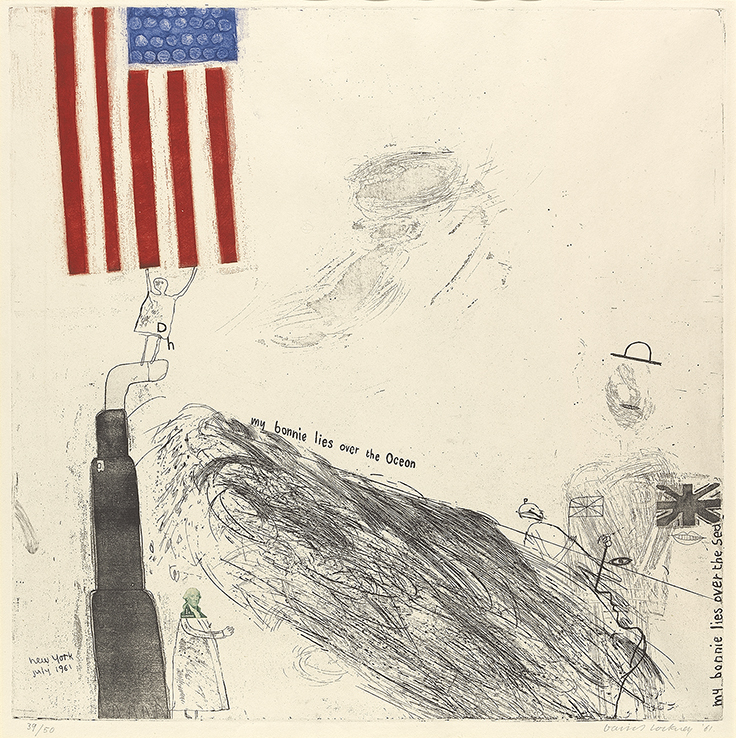


Blond hair
In the evenings back on Long Island, Hockney and Berger watch television. One of the commercial appeals, an advertisement for Lady Clairol hair [NESTED]dye, catches Hockney’s attention: “Is it true blondes have more fun?” Hockney immediately becomes a blond and achieves his signature appearance.

Back in London
Back in London that autumn, he begins a series of etchings based on A Rake’s Progress by William Hogarth (British, 1697–1764), supplemented with his memories of New York. The influence of Hogarth will become increasingly significant with the 1975 production of Stravinsky’s The Rake’s Progress.
Imagined scenes
A raised curtain, a recurring motif throughout Hockney’s body of work over the coming decades, appears for the first time in A Grand Procession of Dignitaries in the Semi-Egyptian Style. He begins the painting while thinking about Constantine Cavafy’s poem “Waiting for the Barbarians,” written in Greek in 1898. Hockney is among a new tide of advocates for Cavafy’s poems, which openly address homosexual desire and were long dismissed as sentimental.
This painting, A Grand Procession of Dignitaries in the Semi-Egyptian Style, and the big works of 1961 … are the works where I became aware as an artist. Previous work was simply a student doing things.
The Egyptian style of painting of course is flat, and since I was breaking the rules of flatness, it was the semi-Egyptian style. The curtain at the top is the first time I used the curtain motif; I wanted it to look theatrical, because I felt the whole event was theatrical—the idea of people putting on a show for the barbarians.
Flight into Italy
On his first visit to Italy, after an initial ride through the Alps in the back of a van without a view, Hockney’s spirits are uplifted at the Uffizi in Florence, where he sees a large, cross-shaped crucifixion scene by the Sienese Gothic painter Duccio (died 1319). It is the strange van experience, however, that he chooses to depict [NESTED]in a painting, Flight into Italy – Swiss Landscape, completed in 1962.
I love Gothic gloom almost as much as Mediterranean or Californian sun, and I thought the misty Alps in winter would be a great thrill. But unfortunately I didn’t see them …. Afterwards when I came back I thought, it’s such a shame when I could have painted a mountain picture; and then I thought, well I can, I can just make it up. And so I painted Flight into Italy – Swiss Landscape.
Exhibitions
Group
- Young Contemporaries, RBA Galleries, London, UK (Feb–Mar 1961); catalogue.
- New Painting 1958–1961, Walker Art Gallery, Liverpool, UK (Jul–Aug 1961), touring exhibition organized by the Arts Council of Great Britain; catalogue.
- The New London Situation, New London Gallery, London, UK (Aug–Sep 1961), later organized by the Arts Council to travel in Britain 1962–1963.
- John Moores Exhibition, Walker Art Gallery, Liverpool, UK (Nov 16, 1961–Jan 14, 1962), Hockney wins the Junior Section Prize; catalogue.
Honor
Honor
- First Prize of the Guinness Award for Etching, Royal College of Art, London.
